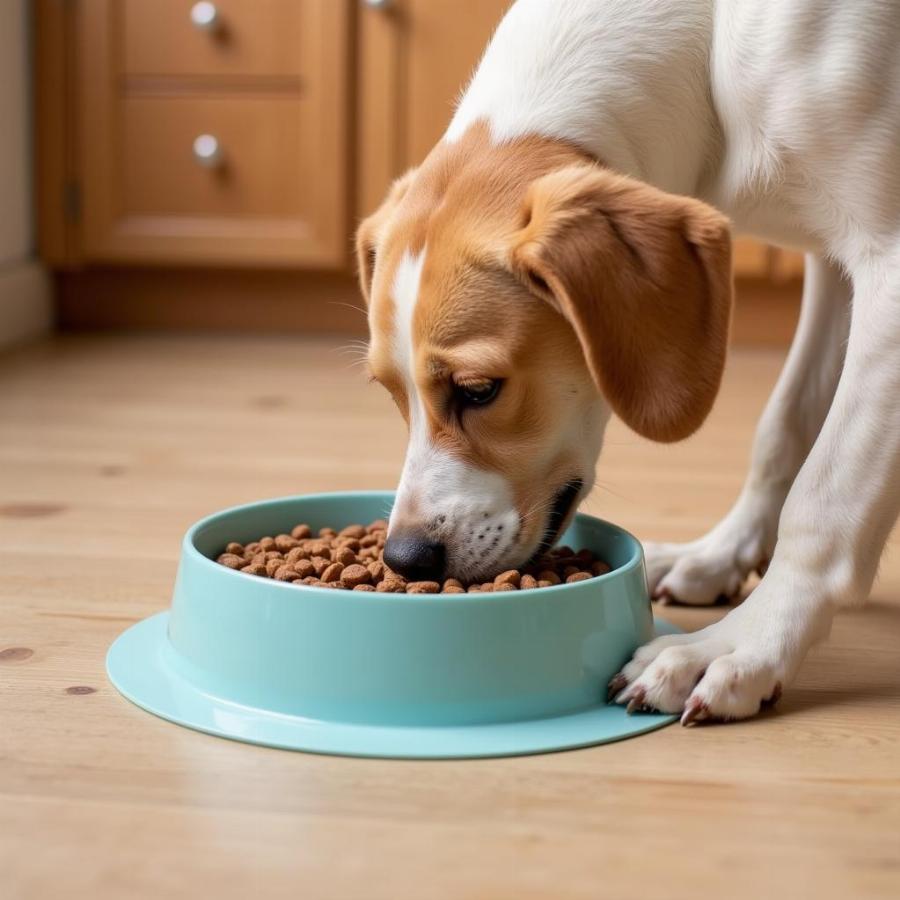Does your dog inhale their food like it’s the last meal on earth? If so, you’re not alone. Many dog owners struggle with this common problem, which can lead to choking, vomiting, and even bloat. The good news is that a simple solution like a slow feeder dog bowl can make mealtime safer and more enjoyable for your furry friend.
Why Slow Down Fast Eaters?
Dogs who eat too quickly don’t have enough time to properly chew their food or allow their bodies to register fullness. This can lead to a number of health issues, including:
- Choking: Large pieces of food can easily become lodged in a dog’s throat if they aren’t chewed properly.
- Vomiting: When a dog eats too quickly, they often swallow a lot of air along with their food. This can cause them to vomit soon after eating.
- Bloat: Bloat is a life-threatening condition that can occur when a dog’s stomach fills with gas and twists. It is more common in large, deep-chested breeds, and eating too quickly is a major risk factor.
Benefits of Using a Slow Feeder Dog Bowl
Switching to a slow feeder dog bowl can have a significant impact on your dog’s eating habits and overall health. Here are some key benefits:
- Reduced Choking Risk: Slow feeder bowls force dogs to take smaller bites, significantly reducing the risk of choking on large pieces of food.
- Improved Digestion: By slowing down eating, these bowls give dogs more time to chew their food thoroughly, leading to better digestion and nutrient absorption.
- Weight Management: Dogs who eat slowly tend to feel fuller faster and consume fewer calories overall, which can help with weight management.
- Mental Stimulation: The challenge of maneuvering food out of a slow feeder bowl can provide mental enrichment and prevent boredom.
Choosing the Right Slow Feeder Dog Bowl
With so many different types of slow feeders on the market, it can be overwhelming to choose the right one for your dog. Consider these factors when making your decision:
1. Bowl Material
- Stainless Steel: Durable, hygienic, and dishwasher-safe.
- Ceramic: Stylish and easy to clean, but can be breakable.
- Plastic: Lightweight and affordable, but may not be as durable.
2. Bowl Size and Capacity
- Choose a bowl size that is appropriate for your dog’s breed and food intake.
- Consider the depth and width of the bowl, as some dogs may find it difficult to reach food in narrow or deep bowls.
3. Obstacle Design
- Ridges and Mazes: These bowls feature raised patterns that force dogs to slow down and use their tongue and teeth to get to the food.
- Central Obstacles: Bowls with a large obstacle in the center encourage dogs to eat around it, extending mealtime.
4. Your Dog’s Eating Habits
- Observe your dog’s eating style and choose a bowl with obstacles that will effectively slow them down.
- Start with a bowl that has a simpler design and gradually introduce more challenging options if needed.
 A dog happily eating from a slow feeder bowl
A dog happily eating from a slow feeder bowl
Tips for Transitioning to a Slow Feeder Dog Bowl
- Gradual Introduction: Start by mixing some of your dog’s regular food into the slow feeder bowl alongside their old bowl.
- Positive Reinforcement: Praise and reward your dog for eating from the slow feeder bowl.
- Patience is Key: It may take some time for your dog to adjust to the new bowl. Don’t get discouraged if they don’t take to it right away.
When to Consult Your Veterinarian
If your dog’s rapid eating is accompanied by other symptoms such as gagging, choking, or frequent vomiting, it’s important to consult your veterinarian. They can rule out any underlying medical conditions and provide personalized recommendations.
“As a veterinarian, I highly recommend slow feeder bowls for dogs who eat too quickly,” says Dr. Emily Parker, DVM. “They are a simple and effective way to improve your dog’s digestion, reduce the risk of health problems, and make mealtime more enjoyable for everyone.”
Conclusion
Choosing the right dog bowl to slow down eating is a small change that can have a big impact on your dog’s health and well-being. By considering your dog’s individual needs and following the tips outlined above, you can help your furry friend enjoy a safer and more satisfying mealtime.
Need help finding the perfect slow feeder bowl for your beloved companion? Beaut Dogs is here to help! We offer a wide range of resources and expert advice to support you on your journey as a dog owner. Contact us at [email protected] for personalized guidance and discover a world of information dedicated to all things dogs!